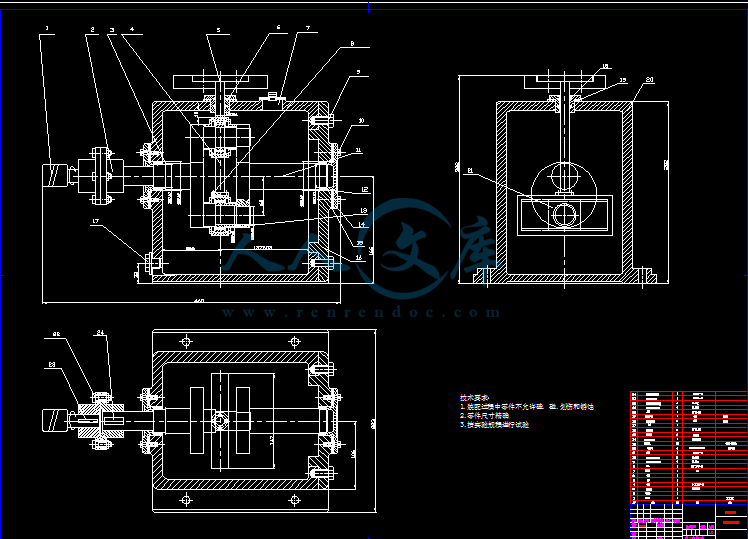【温馨提示】 购买原稿文件请充值后自助下载。
[全部文件] 那张截图中的文件为本资料所有内容,下载后即可获得。
预览截图请勿抄袭,原稿文件完整清晰,无水印,可编辑。
有疑问可以咨询QQ:414951605或1304139763
全套资料带CAD图,QQ联系414951605或1304139763


目 录
前言..................3
摘要..................4
第一章 隔振理论.................................................................6
1.1 振动.......6
1.2 隔振概念.6
1.3 隔振原理.6
1.4 隔振装置性能的影响因素................................................7
1.5 隔振理论在工程上的应用................................................8
第二章 实验台总体方案设计..............................................10
2.1 设计任务与目的...........................................................10
2.2 激振方案的选择...........................................................10
第三章 激振系统的设计.....................................................13
3.1 推杆的设计与校核............................................................13
3.2 滑动轴承的设计与校核......................................................13
3.3 滑块与滑槽的设计与校核....................................................14
3.4 滚动轴承,曲轴,滚针轴承的设计与校核.................................14
3.5 箱体的设计.................................................................17
第四章 激振系统附件的设计....................................................19
4.1 油塞.................................................................19
4.2 轴承盖.................................................................19
4.3 视孔盖.................................................................19
第五章 振动系统的动力选择....................................................20
5.1 选择电动机.................................................................20
5.2 选择电动机的调速方法........................................................21
第六章 激振系统用于汽车部件振动的分析............................22
6.1 汽车座椅振动分析.............................................................22
6.2 汽车减振器振动分析......................................................23
第七章 隔振系统测试与信号分析..........................25
7.1 传感器.................................................................25
7.2 电荷放大器.................................................................26
7.3 示波器,采集器与电子计算机........................................26
第八章 设计小结.................................................................27
参考文献.........28
致谢..................29
英文资料..............
英文翻译..........
附录..................
前 言
机械设备在运转时将不可避免地产生振动,振动是造成工程结构损坏及寿命降低的原因,同时,振动会导致机器和仪器仪表的工作效率、工作质量和工作精度的降低;此外,机械结构的振动是产生结构振动辐射噪声的主要原因,如建筑机械、交通运输机械等产生的噪声是构成城市噪声的主要来源;振动对人体也会产生很大的危害,振动会引起人体内部器官的振动或共振,从而导致疾病的发生,对人体造成危害,严重时会影响人们的生命安全,因此振动是一种不可忽略的公害.
随着经济的发展,高等级公路里程的增加,长途客流已成为我国公路运输的主要特征.在这一背景下,长距离(2000 km以上)、长时间(20 h以上)的驾驶作业已是平常.隔振装置在汽车上发挥着越来越重要的作用,如轮胎、弹簧钢板、减振器、座椅、气囊等等.这些装置缓和了路面不平传给人体的冲击和衰减了由此引起的振动,也给驾驶员和乘员提供舒适、安全的乘座条件及工作条件.所以检测汽车的座椅和减振器是必要和必行的.本文考虑仅对于汽车座椅和减振器的隔振性能进行检测,通过改变其阻尼或刚度,或同时改变其阻尼和刚度,而使其舒适性得以改善.
摘 要
振动在日常生活中是到处可见的.隔振是阻止振源向隔振物体的传递.汽车座椅或减振器的功能都是在人体的敏感频率范围内(2Hz~8Hz)阻止振源向人体的传递.
本设计任务要设计出一套激振装置,给予座椅或减振器以宽频范围的正弦激励,通过检测汽车座椅或减振器的输出振幅,观察其是否在人体敏感频率范围内处于减振状态.如果没有达到理想的减振效果,则通过改变座椅或减振器的刚度或阻尼,或同时改变其刚度及阻尼,以期达到预定的减振要求.
推而广之,本文所设计的激振装置也可用于检验其它种类的隔振装置.
关键词:振动,隔振,座椅,减振器
Abstract:
It is normal that there is the vibration in our daily lives everywhere. The vibration is prevented from vibration source to vibrated object by technology of vibration insulation.
The Automobile seat and anti-vibration device are all belonged to a kinds of anti-vibration. The paper aims at designing a set of vibration exciting device, getting output amplitude while giving sinusoid excitation to the seat or vibration isolator. Through experimenting, the output amplitude was observed whether it is reduce in the frequency domain of 2Hz~8Hz which is sensitivity to human body. If the result of experiment isn’t met the ideal purpose, we can change either the spring stiffness or damp of seat or anti-vibration device, or change spring stiffness and damp of seat or anti-vibration device with the output amplitude was observed again, until the ideal purpose is attained.
This set of vibration exciting device may also be used for the other anti-vibration devices.
Keywords: vibration,anti-vibration,seat,anti-vibration device
第一章 隔振理论
1.1 振动
振动是自然界以及工程技术中普遍存在的自然现象.一方面,振动常常破坏机器的正常工作,加速机器的损坏,造成事故,也危害人体的健康;另一方面我们可以利用隔振的原理,使消极的振动一面转变为积极的,有利于人身健康的一面.引起振动的原因很多.在长期的生活实践中,人们积累了丰富的宝贵经验,掌握了不少行之有效的减少和控制振动的方法.如减少扰动、采取有效的隔振措施等.本文将从隔振的角度出发,设计一种激振器,从而检验汽车驾驶座椅和减振器的隔振效果.
1.2 隔振概念
隔振是在振源和被隔振的物体之间的传递途径中插入适当量值的弹簧和阻尼,切断或阻止振动由振源向隔振物体传递.车辆振动是影响车辆性能的重要因数,这种振动不仅大大降低了车辆行使平顺性,也影响其操纵稳定性.车辆振动严重时,还影响其行使速度;同时车辆振动也是车内噪声的主要来源.研究隔振的原理,将大大的提高汽车的舒适性和平稳性.
 川公网安备: 51019002004831号
川公网安备: 51019002004831号